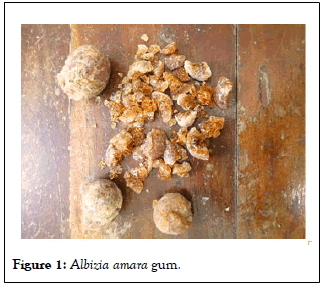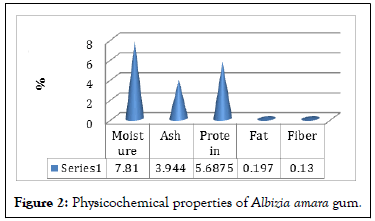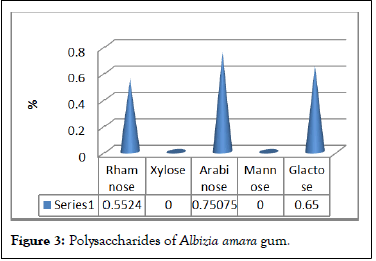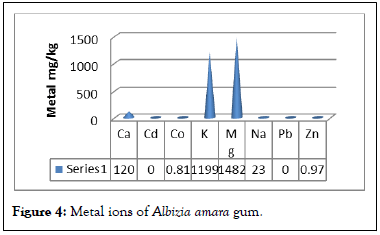Forest Research: Open Access
Open Access
ISSN: 2168-9776
ISSN: 2168-9776
Brief Report - (2023)Volume 12, Issue 6
The aim of this study was to investigate the physico-chemical properties of Albizia Amara gum. The gum samples used in the present study were obtained from South Kordufan State. The values obtained for the various physical and chemical properties were: Moisture content 7.81%, soluble fibre 0.13%, fat 0.197%, ash content 3.94% and protein 5.68%. The metal ions were determined (K, Na, Ca, Mg, Cd, Co, Pb and Zn), and the values are (1198.9 mg/kg), (22.97 mg/kg), (120.05 mg/kg), (1481.6 mg/kg), (0 mg/kg), (0.81 mg/kg), (0 mg/kg) and (0.9 mg/kg). The determination of the polysaccharides of the gum samples showed that the proportion of rhamnose (0.5541%), the proportion of arabinose (0.75075%), the proportion of galactose (0.65%) and the proportion of xylose and mannose (0%). The viscosity of the solution of 10% Albizia Amara gum is 25 cps at room temperature and a pH value of 4.18.
Albizia physico chemical; Gum; Properties
Plant gums are a type of plant exudates or extracts, but differ from resins and other exudates in that they are insoluble in drying oils and organic solvents and decompose completely by heating without melting. Plant gums are biopolymeric materials composed of complex heteropolysaccharides and proteinaceous material as well as some mineral elements [1]. Gums are not crystallizable and are usually composed of carbon, hydrogen, oxygen and nitrogen [2,3]. In addition, acid gums (e.g., gum arabic) contain Ca, Mg, K, Na and Fe. Technically, gum arabic belongs to a group of substances called arabinogalactan proteins. The complex chemical structure of gum has been studied in detail and shows that it is a multifunctional material consisting mainly of a highly branched polysaccharide and a proteinpolysaccharide complex (GAGP) as a minor component [4]. More specifically, it is essentially a very complex polysaccharide consisting mainly of galactose, arabinose, rhamnose and glucuronic acid. In addition to a very small amount of protein [1]. The gums of Acacia species have the same general D-galactan core, but vary in the degree of branching, type and attachment of peripheral L-arabinose and L-rhamnose units. Gums are mainly used in the food and pharmaceutical industries, where their stabilizing, thickening, emulsifying and gelling properties are the most important properties required [5,6].
A gum is generally any water-soluble or water-swellable polysaccharide that can be extracted from marine and terrestrial plants or from microorganisms that have the ability to impart viscosity or gelling properties to their dispersions [7].
The current work focuses on the evaluation of Albizia amara gum by investigating some of its physical and chemical properties required for industrial use.
Materials
The gum samples were collected from a field between latitude 11°46'' and longitude 31°23'' in South Kordufan (Abojebiha). During the collection, only clean nodules emerging under natural environmental conditions were picked directly from the trees. They were all free from contamination by plant bark and other physical substances. The gum of Albizia amara was collected by the author from the area (South Korfufan). Gum of Albizia , which comes from trees of the genus Albizia , forms round, elongated warts of varying size and color, ranging from yellow to dark brown shown in Figure 1 [8].

Figure 1: Albizia amara gum.
Sample preparations
The gum samples were dried at room temperature. The sampless were mechanically crushed and stored in labeled plastic containers for the purpose of this study. The physico-chemical parameters determined and their various methods are described below:
Determination of pH: The pH of the collected gum samples was measured using the Jenway 3020 pH meter.
Moisture content: This was obtained by heating 5 grams of gum sample at 105°C until a constant weight is obtained and the moisture content then calculated as percentage weight loss to total weight of sample.
Protein content: The percentage protein content of the gum samples was determined using the Kjeldahl method
Ash and soluble fibre content: The ash content was determined from the dried sample after determining the moisture content. The dried sample was ignited at 550°C in a desiccator and weighed. The ash content was then recorded as the percentage weight loss after ignition compared to the original sample. The amount of total soluble fibre was determined by subtracting the total ash, water and protein content from 100 according to the AOAC procedures [9].
Absolute Viscosity: Viscosity was measured using Brookfield viscometer (MYR viscometer-version L) at 10% concentration.
Metal ions: The gum samples were analysed for metal ions (K, Na, Ca, Mg, Cd, Co, Pb and Zn) according to standard atomic absorption conditions (Atomic Absorption Spectrometer, Model Buck scientific USA, 2005) as shown in the Table 1.
| Metal | WI (Nm) | Slit (Nm) | Detect limit (mg/L) | Sens check (mg/L) | Linear range (mg/L) | Flame Type (Colour) |
|---|---|---|---|---|---|---|
| Calcium (Ca) | 422.7 | 0.7 | 0.05 | 2 | 5 | N-A, rich/red |
| Potassium (K) | 766.5 | 0.7 | 0.01 | 1 | 3 | A-A, lean/blue |
| Magnesium (Mg) | 285.2 | 0.7 | 0.005 | 0.015 | 0.015 | A-A, lean/blue |
| Sodium (Na) | 589 | 0.2 | 0.005 | 0.25 | 2 | A-A, lean/blue |
| Cadmium (Cd) | 228.9 | 0.7 | 0.01 | 0.75 | 2 | A-A, lean/blue |
| Cobalt (Co) | 240.7 | 0.2 | 0.05 | 3.5 | 5 | A-A, lean/blue |
| Lead (Pb) | 283.3 | 0.7 | 0.08 | 10 | 20 | A-A, lean/blue |
| Zinc (Zn) | 213.9 | 0.7 | 0.005 | 0.5 | 2.5 | A-A, lean/blue |
Table 1: Flame Atomic Absorption Concentration Ranges.
Polysaccharides: The polysaccharide for gum samples was determined according to Balaban.
Data were recorded in replicates for all parameters and analyzed using Microsoft Excel (2007) computer software.
The results of experimental properties of Albiza-Amara gum show that percent moisture content (7.81%), percent ash content (3.94%), percent protein content (5.68), percent fat content (0.197) and percent fiber content (0.13) shown in Figure 2. When we compare these results with the characteristics of hashab gum, we find that the percent protein content of Arad gum is higher than that of hashab gum and that the percent moisture content is different [5]. Said that the moisture content of hashab gum is 9.76 and the protein content is 2.15, while reported that the protein content and moisture content are 3.4 and 13.4 respectively [10].

Figure 2: Physicochemical properties of Albizia amara gum.
The results of the analysis of some polysaccharides found in Albiza amara gum showed that the percentage of rhamnose (0.5524), the percentage of arabinose (0.75075), the percentage of galactose (0.65) and (0%) for xylose and mannose shown in Figure 3. From these results, the sugar content of Albiza amara gum is low compared to that of Hashab gum, where the two types of gums do not contain mannose and xylose, he said that gum arabic from Acacia senegal contains 14% rhamnose, 29%arabinose and 36% galactose [11].

Figure 3: Polysaccharides of Albizia amara gum.
The analysis of metal ions in Albiza amara gum is shown in Figure 4 and shows that the amount of K (1198.9), Na (22.97), Ca (120.05), Mg (1481.6), Cd (0), Co (0.81), Pb (0) and Zn (0.97) [12]. reported that the metal ion analysis of gum exudates of the genus Albizia are complex salts of calcium, potassium, magnesium and sodium in decreasing proportions. Other metals such as zinc, copper, iron, lead and Aluminium are present in trace amounts.

Figure 4: Metal ions of Albizia amara gum.
The viscosity value of the Albiza amara gum samples in the concentration range of 10% is (25 csp). The pH measurement shows that the Albiza amara gum samples were slightly acidic (4.18). The viscosity and pH values are in good agreement with the viscosity and pH values reported by several authors for gum arabic and other acacia gums [13]. Reported that the viscosity of an Albizia solution is imperceptibly higher than that of a gum arabic solution, but lower than the viscosity of gum karaya at the same concentration.
The viscosity value of the Albiza amara gum samples in the concentration range of 10% is (25 csp). The pH measurement shows that the Albiza amara gum samples were slightly acidic (4.18). The viscosity and pH values are in good agreement with the viscosity and pH values reported by several authors for gum arabic and other acacia gums. (Mbuna 1997) reported that the viscosity of an Albizia solution is imperceptibly higher than that of a gum arabic solution, but lower than the viscosity of gum karaya at the same concentration.
[PubMed]
[Crossref] [Google Scholar] [Pubmed]
Citation: Ahmed EEE (2024) Physicochemical Investigation of Exudates of Albizia Amara Tree from South Kordufan State-Sudan. J For Res. 12:488.
Received: 06-Dec-2023, Manuscript No. JFOR-23-28372; Editor assigned: 08-Dec-2023, Pre QC No. JFOR-23-28372 (PQ); Reviewed: 22-Dec-2023, QC No. JFOR-23-28372; Revised: 29-Dec-2023, Manuscript No. JFOR-23-28372 (R); Published: 05-Jan-2024 , DOI: 10.35248/2168-9776.23.12.488
Copyright: © 2024 Ahmed EEE. This is an open-access article distributed under the terms of the Creative Commons Attribution License, which permits unrestricted use, distribution, and reproduction in any medium, provided the original author and source are credited.